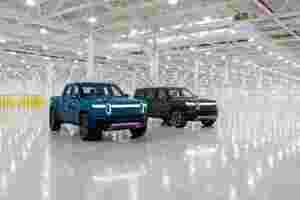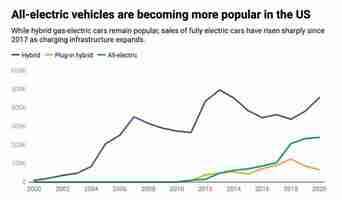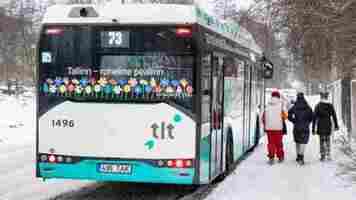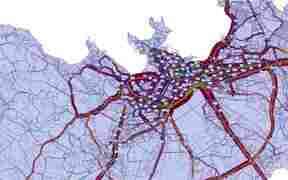US bill proposal aims to get truck-loving Americans into EVs
With COP26 in full swing , Democrats in the US House of Representatives are slowly working on doing their part to fight climate change. Their focus? The heart and soul of America: the big-ass car. This week they announced further amendments to the current Build Back Better Act before the House which offers some big wins for social spending and sustainable transport. The bill before the house is all part of a $3.5 trillion budget dedicated to social and environmental benefits .

But let’s dig into how exactly this will affect American transportation.
What’s new in the bill: benefits direct to the consumer


The updated bill means electric vans, SUVs, and trucks at a retail price up to $80,000 are eligible for a $12,500 credit. This will bring more models into the credit scheme as it was formerly capped at $64,000 for vans, $69,000 for SUVs, and $74,000 for pickup trucks. Meanwhile, sedans still remain capped at $55,000.
So, what can we gather from this? Well, this might make the transition to EVs smoother for truck lovers and SUV owners. Car ownership is deeply cultural in the US, so if we’re going to aim for 100% electrified car fleet as soon as possible, making the ‘cultural strain’ as low as possible sounds like a good idea.
I can also see this appeasing people who have practical concerns, like contractors, who use their personal vehicles for work.
Putting US automakers first
The US is already facing criticism by overseas automakers and Republicans for the bill’s preference for union-made vehicles from local companies. If successfully voted upon, it means consumers can claim an added $4,500 credit for vehicles assembled at a domestic unionized plant. In contrast, EVs that are American-made but not union-built qualify for a mere $500 extra in subsidies.
There was a plan to phase out tax credits after automakers hit 200,000 electric vehicles sold, but its cancelation means big automakers like GM and Tesla will continue to enjoy the credits.
$5 billion to replace certain heavy-duty vehicles, such as refuse trucks and school buses, with zero-emission vehicles through a new grant program at the Environmental Protection Agency (EPA).
$17.5 billion towards decarbonizing federal buildings and fleets. This includes the installation of electric vehicle charging stations for government buildings.
A $13.5 billion investment in electric vehicle infrastructure to support the development of an electric vehicle charging network. This funding will go toward the construction of charging infrastructure in publicly accessible locations, multi-unit housing structures, workplaces, and underserved areas. America lags behind much of the world regarding access to public EV charging, so this is sorely needed.
$7 billion in multiple loans and grant programs at DOE to support the development of innovative technologies and American manufacturing of zero-emission transportation.
Significantly, the bill also includes a $9 billion investment into updating the energy grid through grants and loans for grid infrastructure modernizing. This is crucial to ensure grid reliability not only for the mass roll of EVs in decades to come but also the impact of extreme weather events on the grid.
Bikes are (finally) a real part of the climate change solution
One of the greatest parts of the bill in general, is that is doesn’t forget ebikes — as often happens in the noise around electric vehicles.
The bill proposes a 30% electric bike tax credit, which helps incentivize ebike adoption. The US’s legislative and infrastructural changes are already resulting in massive industry growth and investment. In February, a federal E-BIKE act ebikes meant that ebikes are no longer classified as motor vehicles or off-road vehicles but are properly defined within three classes. Owners can therefore ride them on the road, unlike in the UK and Australia.
The current bill before the House also dedicates $10 billion to high-speed rail expansion, which is a big deal for a country that has so greatly neglected public transport infrastructure for decades.
Ultimately, this is the most significant US government investment we’ve seen in sustainable transport. Hopefully, it’s just the start of things to come — assuming the bill passes in the Senate without too much dilution.
In the future, your electric car will power your house
As manufacturers introduce new models of electric vehicles, demand for them is growing steadily. New EV sales in the U.S. roughly doubled in 2021 and could double again in 2022, from 600,000 to 1.2 million . Auto industry leaders expect that EVs could account for at least half of all new U.S. car sales by the end of the decade.

EVs appeal to different customers in different ways. Many buyers want to help protect the environment ; others want to save money on gasoline or try out the latest, coolest technology .
In areas like California and Texas that have suffered large weather-related power failures in recent years, consumers are starting to consider EVs in a new way: as a potential electricity source when the lights go out. Ford has made backup power a selling point of its electric F-150 Lightning pickup truck, which is due to arrive in showrooms sometime in the spring of 2022. The company says the truck can fully power an average house for three days on a single charge .
So far, though, only a few vehicles can charge a house in this way , and it requires special equipment. Vehicle-to-home charging, or V2H, also poses challenges for utilities. Here are some of the key issues involved in bringing V2H to the mainstream.
The ABCs of vehicle-to-home charging
The biggest factors involved in using an EV to power a home are the size of the vehicles’s battery and whether it is set up for “bidirectional charging.” Vehicles with this capacity can use electricity to charge their batteries and can send electricity from a charged battery to a house.
There are two ways to judge how “big” a battery is. The first is the total amount of electric fuel stored in the battery. This is the most widely publicized number from EV manufacturers, because it determines how far the car can drive.
Batteries for electric sedans like the Tesla Model S or the Nissan Leaf might be able to store 80 to 100 kilowatt-hours of electric fuel. For reference, 1 kilowatt-hour is enough energy to power a typical refrigerator for five hours.
A typical U.S. home uses around 30 kilowatt-hours per day , depending on its size and which appliances people use. This means that a typical EV battery can store enough electric fuel to supply the total energy needs of a typical home for a couple of days.


The other way to assess the capacity of an EV battery is its maximum power output in backup power mode. This represents the largest amount of electric fuel that could be delivered to the grid or a house at any given moment. An EV operating in backup mode will typically have a lower maximum power output than when in driving mode. The backup power capacity is important, because it indicates how many appliances an EV battery could power at once.
This figure is not as widely publicized for all EVs, in part because vehicle-to-home charging hasn’t yet been widely deployed. Ford has advertised that its electric F-150 would have a maximum V2H power output of 2.4 kilowatts, potentially upgradable to 9.6 kilowatts – about the same as a single higher-end Tesla Powerwall home energy storage unit.
On the low end, 2.4 kilowatts is enough power to run eight to 10 refrigerators at the same time and could run much of a typical household continuously for a few days – or much more if the electricity is used sparingly. On the high end, a power level of 9.6 kilowatts could run more appliances or higher-powered ones, but that level of usage would drain the battery faster.
Storing power when it’s cheaper
To draw home power from their cars, EV owners need a bidirectional charger and an electric vehicle that is compatible with V2H. Bidirectional chargers are already commercially available, though some can add several thousand dollars to the price of the car.
A limited number of EVs on the market now are compatible with V2H, including the Ford Lightning, Nissan Leaf and Mitsubishi Outlander . General Motors and Pacific Gas & Electric plan to test V2H charging in California in mid-2022 using multiple GM electric vehicles.
Some homeowners might hope to use their vehicle for what utility planners call “ peak shaving ” – drawing household power from their EV during the day instead of relying on the grid, thus reducing their electricity purchases during peak demand hours. To do this, they might need to install special metering equipment that can control both the discharging of the vehicle battery and the flow of power from the grid to the home.
Peak shaving makes the most sense in areas where utilities have time-of-use electric pricing, which makes power from the grid much more expensive during the day than at night. A peak-shaving household would use cheap electricity at night to charge the EV battery and then store that electricity to use during the day, avoiding high electricity prices.
Utilities and the future of V2H
While V2H capabilities exist now, it will likely be a little while before they see widespread adoption. The market for V2H-compatible electric vehicles will need to grow, and the costs of V2H chargers and other equipment will need to come down. As with Tesla’s Powerwall, the biggest market for V2H will probably be homeowners who want backup power for when the grid fails but don’t want to invest in a special generator just for that purpose.
Enabling homeowners to use their vehicles as backup when the power goes down would reduce the social impacts of large-scale blackouts. It also would give utilities more time to restore service – especially when there is substantial damage to power poles and wires, as occurred during Hurricane Ida in Louisiana in August 2021.
Power companies will still have to spend money building and maintaining the grid to provide reliable service. In some areas, those grid maintenance costs are passed on to customers through peak demand charges, meaning that people without V2H – who will be more likely to have lower incomes – may well bear a greater share of those costs than those with V2H, who will avoid purchasing peak power from the grid. This is especially true if lots of EV owners use rooftop solar panels to charge their car batteries and use those vehicles for peak shaving.
Still, even with V2H, electric vehicles are a huge potential market for electric utilities. Bidirectional charging is also an integral part of a broader vision for a next-generation electric grid in which millions of EVs are constantly taking power from the grid and giving it back – a key element of an electrified future. First, though, energy planners will need to understand how their customers use V2H and how it may affect their strategies for keeping the grid reliable.
This article by Seth Blumsack , Professor of Energy and Environmental Economics and International Affairs, Penn State is republished from The Conversation under a Creative Commons license. Read the original article .
Tallinn introduces predictive digital transport model
This article was originally published by Christopher Carey on Cities Today , the leading news platform on urban mobility and innovation, reaching an international audience of city leaders. For the latest updates, follow Cities Today on Twitter , Facebook , LinkedIn , Instagram , and YouTube , or sign up for Cities Today News.

Estonia’s capital Tallinn is introducing a digital transport model which it says can forecast and analyze the city’s mobility needs to improve urban planning.
The tool includes data on 130,000 different road sections across the city which are constantly updated, and takes into account the movement of cars, public transport, lorries and pedestrians.
It can also distinguish between 12 different types of road users or user groups, including students, workers and pensioners, and also takes into account complex movement patterns such as whether a person takes children to school on the way to work.


“[The model] makes it possible to anticipate transport problems and understand their causes, and to make decisions that support the overall development of the city and to anticipate the effects of decisions to be taken,” said Andrei Novikov, Deputy Mayor of Tallinn.
“It is not an instrument for a specific project, but a permanent internal analysis tool that can be used to assess the feasibility and impact of major infrastructure investments on traffic.
“Among other things, we can assess the different needs of the people in each region [and] the traffic simulations used in the model can, for example, make better decisions about what the capacity needs of one or the other should be today, or, for example, assess decisions to upgrade the city’s public transport network.”
Developed by the Tallinn Transport Authority in conjunction with German software firm PTV Group, the model incorporates all mobility data available to the city, including an analysis of the results of social surveys carried out in the city over the last five years, the road network and traffic frequencies.